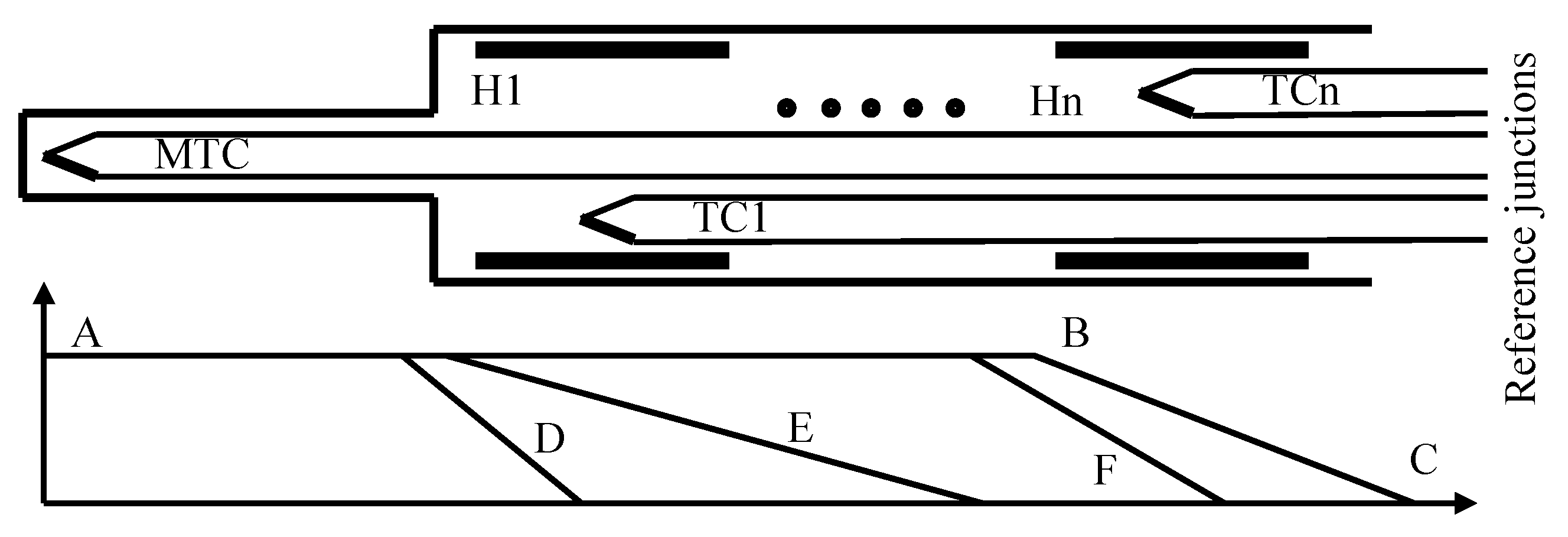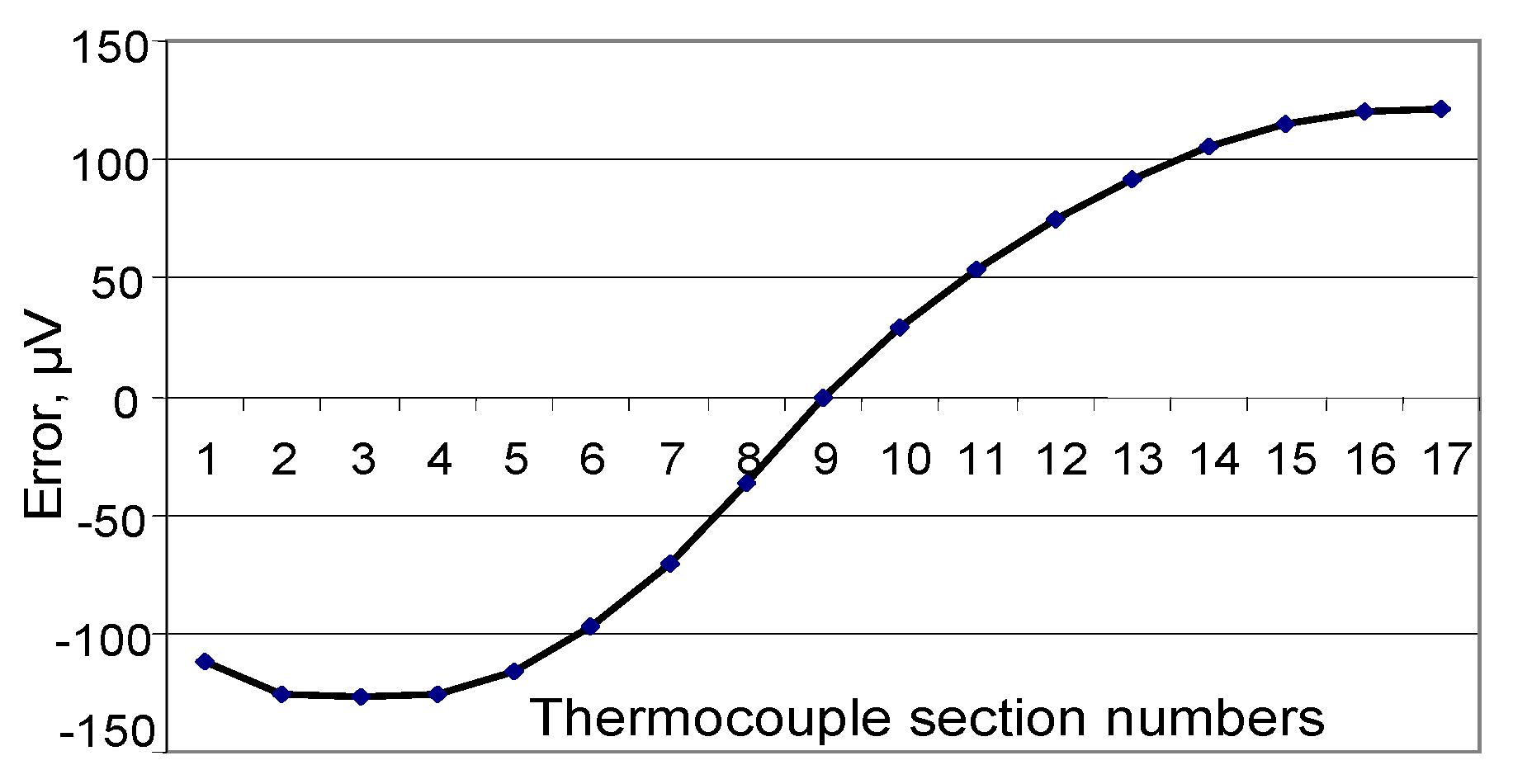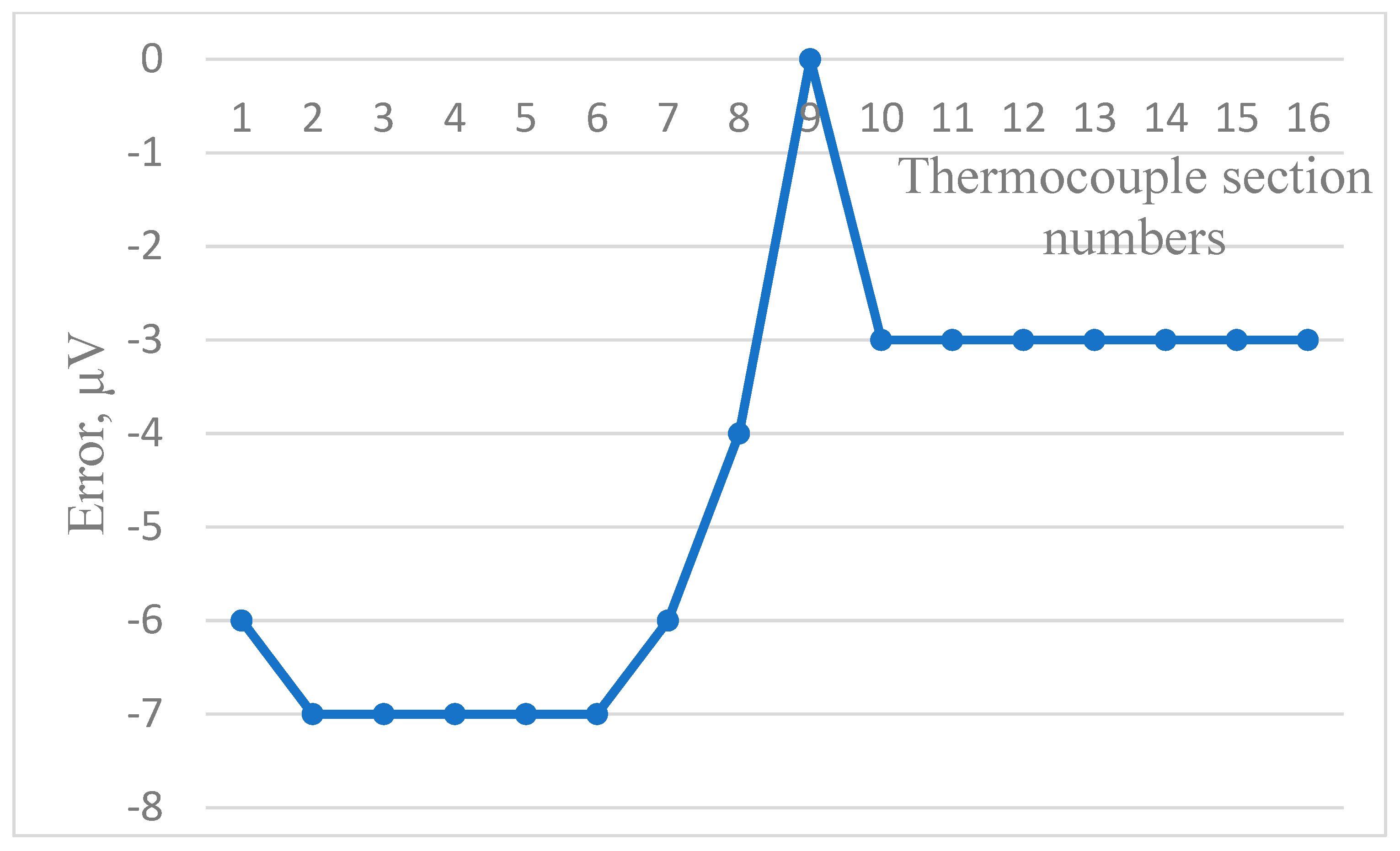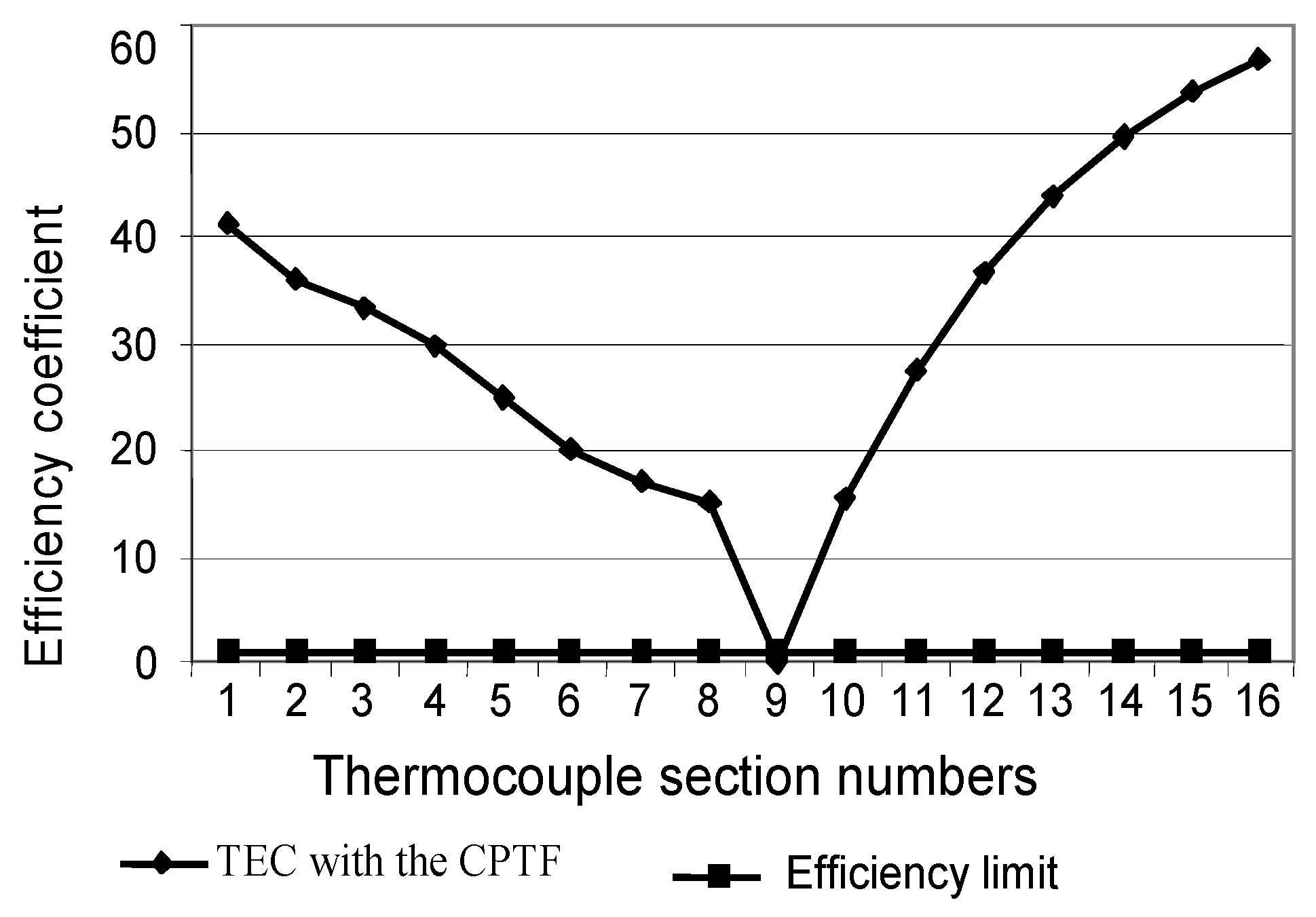Simulating Error Due to Acquired Thermoelectric Inhomogeneity
Abstract
:1. Introduction
2. State of the Art
- Error due to drift of the CF of a TC. It is a gradual change in the developed thermal electromotive force (thermo-emf) in time in a constant temperature field along the TC legs. This error appears because of the degradation of TC legs under the influence of temperature and time of their operation.
- Error due to acquired thermoelectric inhomogeneity. It is a change in the developed thermo-emf when the temperature distribution along TC legs changes (i.e., the temperature field along the TC changes), even for constant temperatures of the measuring and reference junctions. This error appears because of the degradation of the TC legs and changes in the temperature field along them.
3. The Technique of Modelling Error Due to Inhomogeneity
- The temperature of the reference junctions of the TC is 0 °C. At this temperature, the TC sections from 1 to 8 are operated.
- The temperature of the measuring junction of the TC is 800 °C. At this operating temperature, the TC sections from 17 to 24 are operated.
- The sections of TC from 9 to 16 are operated in the zone of the temperature gradient.
- The temperatures of sections can change within the range from 0 °C to 800 °C. The temperature drop across the i-th section is as follows: .
- The sections of the TC are homogeneous along their length (i.e., there is no error due to acquired heterogeneity within each section).
- The operating temperature of each TC section is considered the average temperature of temperatures of its ends before the change in temperature field.
- The instantaneous temperature of the TC section is considered the average temperature of the ends of each section after the change in temperature field.
4. The Results of the Modelling of Error Due to Inhomogeneity
5. Conclusions
- The maximum deviation of the CF from the nominal for the whole type K TC is 430 μV. The initial sensitivity of the type K TC is 40 μV/°C; thus, maximum temperature measurement error due to thermoelectric inhomogeneity of the conventional TC acquired during long-term operation can exceed 10 °C, which cannot be neglected.
- The maximum sensitivity of both the conventional TC and the TCTF to changes in the temperature field of the measurement object is for small changes in the temperature field, which makes this error even more dangerous.
- The efficiency of the TCTF is quite high—the maximum value of error due to acquired thermoelectric inhomogeneity of the legs of the MTC is reduced by several tens of times to 0.2. The high efficiency of error compensation allows using all drift correction methods considered in [15] with high reliability.
- The high efficiency of the TCTF was confirmed in the studies above. The bigger the changes in the temperature field of the measurement object, the higher the efficiency of the use of the TCTF. However, it is achieved due to the relatively large structural complexity of the proposed sensor [15,25,26].
- The limit of effective use of the TCTF is determined by the changes in temperature along the TC legs. In this particular case, when the temperature changes exceed 7 °C, it is reasonable to use the TCTF, because its error due to inhomogeneity is less than that of the conventional type K TC.
- On the other hand, in a stable temperature field of the measurement object, the TCTF has a greater error due to acquired inhomogeneity than the conventional TC. This is because of the influence of the error in the temperature-control system. The reduction in this error will expand the limits of the effective application of the TCTF.
- The dependence of residual error due to acquired thermoelectric inhomogeneity of the MTC of the TCTF on its structural complexity for given changes in the temperature field of the object remains unexplored. It is necessary to create a theoretical basis for designing the TCTF to ensure the necessary accuracy of temperature measurement results under the given conditions.
Author Contributions
Funding
Institutional Review Board Statement
Informed Consent Statement
Data Availability Statement
Acknowledgments
Conflicts of Interest
References
- Birch, J. Benefit of Legal Metrology for the Economy and Society. A study for the International Committee of Legal Metrology. Available online: https://www.oiml.org/en/files/pdf_e/e002-e03.pdf (accessed on 9 August 2024).
- Glowacz, A. Ventilation diagnosis of minigrinders using thermal images. Expert Syst. Appl. 2024, 237 Pt A, 121435. [Google Scholar] [CrossRef]
- Michałowska, J.; Wac-Włodarczyk, A.; Kozieł, J. Monitoring of the specific absorption rate in terms of electromagnetic hazards. J. Ecol. Eng. 2020, 21, 224–230. [Google Scholar] [CrossRef]
- Stolyarchuk, P.; Mikhalieva, M.; Bubela, T.; Basalkevych, O. Qualitative and quantitative research on pesticide chemical admixture in liquids. In Proceedings of the 2013 IEEE 7th International Conference on Intelligent Data Acquisition and Advanced Computing Systems, IDAACS 2013, Berlin, Germany, 12–14 September 2013; Volume 1, pp. 82–85. [Google Scholar]
- Twardowski, P.; Legutko, S.; Krolczyk, G.M.; Hloch, S. Investigation of wear and tool life of coated carbide and cubic boron nitride cutting tools in high speed milling. Adv. Mech. Eng. 2015, 7, 1687814015590216. [Google Scholar] [CrossRef]
- Hrusha, V.; Osolinskiy, O.; Daponte, P.; Grimaldi, D.; Kochan, R.; Sachenko, A.; Turchenko, I. Distributed Web-based measurement system. In Proceedings of the 2005 IEEE Intelligent Data Acquisition and Advanced Computing Systems: Technology and Applications, Sofia, Bulgaria, 5–7 September 2005; pp. 355–358. [Google Scholar]
- Łuczak, P.; Kucharski, P.; Jaworski, T.; Perenc, I.; Ślot, K.; Kucharski, J. Boosting intelligent data analysis in smart sensors by integrating knowledge and machine learning. Sensors 2021, 21, 6168. [Google Scholar] [CrossRef] [PubMed]
- Greengard, S. The Internet of Things; MIT Press: Cambridge, MA, USA, 2015. [Google Scholar]
- Hu, Z.; Dychka, I.; Onai, M.; Zhykin, Y. Blind Payment Protocol for Payment Channel Networks. Int. J. Comput. Netw. Inf. Secur. 2019, 11, 22–28. [Google Scholar] [CrossRef]
- Webster, J. Measurement, Instrumentation, and Sensors Handbook. CRCnetBase 1999. Available online: http://www.crcnetbase.com/isbn/9780415876179 (accessed on 9 August 2024).
- Jun, S.; Kochan, O.; Vasylkiv, N.; Kochan, R. A method of correcting the error of temperature measurements due to acquired inhomogeneity of the electrodes of thermocouples. Meas. Tech. 2015, 58, 904–910. [Google Scholar] [CrossRef]
- Kim, Y.G.; Song, C.H.; Gam, K.S.; Yang, I. Change in inhomogeneity with temperature between 180 °C and 950 °C in base-metal thermocouples. Meas. Sci. Technol. 2009, 20, 075102. [Google Scholar] [CrossRef]
- Kirenkov, I. Some laws of thermoelectric inhomogeneity. In Research in the Field of Temperature Measurements; VNIIM: Saint Petersburg/Moscow, Russia, 1976; pp. 11–15. [Google Scholar]
- Jun, S.; Kochan, O. The mechanism of the occurrence of acquired thermoelectric inhomogeneity of thermocouples and its effect on the result of temperature measurement. Meas. Tech. 2015, 57, 1160–1166. [Google Scholar] [CrossRef]
- Jun, S.; Kochan, O.; Jotsov, V.S. Methods of Reducing the Effect of the Acquired Thermoelectric Inhomogeneity of Thermocouples on Temperature Measurement Error. Meas. Tech. 2015, 58, 327–331. [Google Scholar] [CrossRef]
- Sachenko, A.; Kochan, V.; Kochan, R.; Turchenko, V.; Tsahouridis, K.; Laopoulos, T. Error compensation in an intelligent sensing instrumentation system. In Proceedings of the Instrumentation and Measurement Technology Conference, IMTC, Budapest, Hungary, 21–23 May 2001; Volume 2, pp. 869–874. [Google Scholar]
- White, W.P. The constancy of thermoelements. Phys. Rev. 1906, 23, 449–474. [Google Scholar] [CrossRef]
- Southworth, D.J. Temperatuzre calibration with isotech block baths. In Handbook of Isothermal Corporation Limited; Isotech: Hatfield, PA, USA, 1999. [Google Scholar]
- Sloneker, K.C. Thermocouple inhomogeneity. Ceram. Ind. 2009, 159, 13–18. [Google Scholar]
- Skifton, R. High-temperature irradiation-resistant thermocouple instability model for in-pile reactor use. Front. Energy Res. 2023, 11, 1099584. [Google Scholar] [CrossRef]
- Narendra Ilaya Pallavan, P.; Srinivasan, S.; Arumugam, V. Estimation of thermo oxidation on chromel–alumel thermocouple. In Advances in Materials Research: Select Proceedings of ICAMR 2019; Springer: Singapore, 2021; pp. 897–902. [Google Scholar]
- Rogelberg, N.; Nuzhnov, A.; Pokrovskaya, G. The stability of the chromel-alumel thermocouples’ thermoelectric power at temperatures up to 800 C during up to 10000 hours. In Investigation of Alloys for Thermocouples: In Proceedings “Giprotsvetmetobrabotka” No. XXIX.—“Metallurgy”; USSR: Moscow, Russia, 1969; pp. 33–41. [Google Scholar]
- Webster, E.S. Low-temperature drift in MIMS base-metal thermocouples. Int. J. Thermoph. 2014, 35, 574–595. [Google Scholar] [CrossRef]
- Edler, F. Scaling of thermoelectric inhomogeneities with temperature in platinum–rhodium alloyed thermocouples. Metrologia 2023, 60, 035005. [Google Scholar] [CrossRef]
- Kochan, O.; Kochan, R.; Bojko, O.; Chyrka, M. Temperature measurement system based on thermocouple with controlled temperature field. In Proceedings of the 4th IEEE International Workshop IDAACS’2007, Dortmund, Germany, 6–8 September 2007; pp. 47–51. [Google Scholar]
- Jun, S.; Kochan, O.; Kochan, V.; Wang, C. Development and investigation of the method for compensating thermoelectric inhomogeneity error. Int. J. Thermoph. 2016, 37, 10. [Google Scholar] [CrossRef]
- Chen, Z.; Kochan, O.; Jun, S.; Demkiv, T. Decreasing of Thermocouple Inhomogeneity Impact on Temperature Measurement Error. Sens. Transducers 2013, 160, 509–513. [Google Scholar]
- Ping, X.; Li, A.; Jiwei, H.; Kochan, O.; Przystupa, K.; Majewski, J. Simulating Error Due to Inhomogeneity of Type K Thermocouples. In Proceedings of the 2023 14th International Conference on Measurement, Smolenice, Slovakia, 29–31 May 2023; pp. 213–216. [Google Scholar]
- Wang, J.; Kochan, O.; Przystupa, K.; Su, J. Information-measuring System to Study the Thermocouple with Controlled Temperature Field. Meas. Sci. Rev. 2019, 19, 161–169. [Google Scholar] [CrossRef]
- Vasylkiv, N.; Kochan, O.; Kochan, R.; Chyrka, M. The control system of the profile of temperature field. In Proceedings of the Intelligent Data Acquisition and Advanced Computing Systems: Technology and Applications, IDAACS, IEEE International Workshop on 2009, Rende, Italy, 21–23 September 2009; pp. 201–206. [Google Scholar]









| The Direction of Change in the Temperature Field | |
|---|---|
| Towards the Reference Junctions | Towards the Measuring Junction |
| 7 °C | 6.5 °C |
Disclaimer/Publisher’s Note: The statements, opinions and data contained in all publications are solely those of the individual author(s) and contributor(s) and not of MDPI and/or the editor(s). MDPI and/or the editor(s) disclaim responsibility for any injury to people or property resulting from any ideas, methods, instructions or products referred to in the content. |
© 2024 by the authors. Licensee MDPI, Basel, Switzerland. This article is an open access article distributed under the terms and conditions of the Creative Commons Attribution (CC BY) license (https://creativecommons.org/licenses/by/4.0/).
Share and Cite
Li, Z.; Chen, J. Simulating Error Due to Acquired Thermoelectric Inhomogeneity. Sensors 2024, 24, 5256. https://doi.org/10.3390/s24165256
Li Z, Chen J. Simulating Error Due to Acquired Thermoelectric Inhomogeneity. Sensors. 2024; 24(16):5256. https://doi.org/10.3390/s24165256
Chicago/Turabian StyleLi, Zida, and Jingliang Chen. 2024. "Simulating Error Due to Acquired Thermoelectric Inhomogeneity" Sensors 24, no. 16: 5256. https://doi.org/10.3390/s24165256




